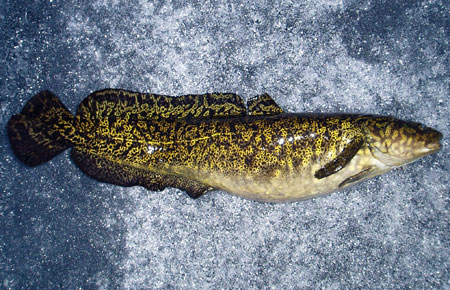Burbot
(Lota lota)
Species Profile
Did You Know?
Burbot have superior table qualities and are often times referred to as “poor man’s lobster” in Alaska.
General Description
Burbot Lota lota are a rather unusual looking fish. They are not the most attractive fish and generally do not fight hard; however, they are popular with sport and subsistence users because of their table quality. They have a delicate white meat, a treat for Alaskans living away from the coast. Burbot have mottled skin that ranges in color from black to grey to olive and even yellow. They have elongated dorsal and anal fins that extend all the way to a rounded caudal fin and a distinct single soft barb on their lower jaw. Burbot appear to be scaleless but actually have small, almost microscopic scales. They are a relatively long-lived, slow growing fish and in Alaska, typically do not reach sexual maturity until age 6 or 7. A trait that sets them apart from other freshwater fish is that they spawn in mid to late winter.
Burbot are often times referred to as ling or lingcod. Taxonomically, this is incorrect though. Lingcod are in the family Hexagrammidae (commonly known as the greenling family), whereas burbot are in the Gadidae family (commonly known as the cod family). In fact, burbot are the only freshwater cod in North America.
Life History
Growth and Reproduction
Burbot are a relatively long-lived and slow-growing species. In Alaska, burbot older than 20 years are not uncommon. It typically takes burbot from five to seven years to reach 18 inches in length. This is also the length at which most Alaska burbot spawn for the first time. Burbot spawn under the ice in late winter (February to March) and have been observed to mill together forming a large writhing ball while spawning. Eggs are very small (about 1 mm in diameter), and a large burbot can produce over a million eggs. Burbot do not make nests to spawn, rather they just broadcast spawn in the water column letting the eggs and milt free fall to rest on the bottom.
Feeding Ecology
Young burbot feed mainly on insects and other invertebrates. By the age of five or six, burbot begin to feed almost exclusively on fish. Adult burbot can appear sluggish, but they are voracious predators, feeding mostly at night. Once a burbot has captured a fish, it is reluctant to give it up. Its large mouth, strong jaw, and large number of inward slanting teeth account for the burbot’s efficiency as a predator. Whitefish, sculpins, lampreys, and other burbot are common food items. Burbot will also sometimes eat mice or shrews.
Range and Habitat
Burbot are distributed in fresh waters throughout North America, Europe and Asia with their range extending southward to about 40 degrees north latitude. They occupy most large clear and glacial rivers and many lakes throughout most of Alaska. However, burbot are absent from Southeast Alaska. Burbot are known by a number of different names including lawyer, loache, eel pout, methy, lush, lingcod, and mud shark. The largest sport fisheries occur for burbot in the Tanana River, and lakes in the upper Tanana, Upper Copper and Upper Susitna river drainages.
Status, Trends, and Threats
Robust populations of burbot exist in the glacial colored Kuskokwim, Yukon, Tanana and Copper rivers. Most lake populations are also healthy but some of the road accessible lakes in the interior have special restrictions due to concerns of overfishing. Since burbot are long lived and relatively late to mature, they are susceptible to overharvest. Many populations of burbot in the Glennallen area were overharvested in the 1970's and 1980's when set lines were allowed, but through proper management actions, most of the populations have recovered now and support healthy populations.
Fast Facts
-
Size
Varies by drainage, but average 3-5 lbs with fish over 8 lbs (trophy size for the ADF&G Trophy Fish Program) not uncommon in the Yukon and Tanana Rivers. -
Range/Distribution
Burbot are distributed in fresh waters throughout North America, Europe and Asia with their range extending southward to about 40 degrees north latitude. -
Diet
Small burbot eat zooplankton and insects, larger burbot prefer fish. -
Predators
Other fish (e.g., burbot, pike), otter, mink, birds (e.g., loons, mergansers, terns, gulls) and humans. -
Reproduction
Spawn in winter under the ice, broadcast spawn, eggs are very small (about 1 mm in diameter). -
Other names
lawyer, loche, eel pout, methy, lush, lingcod, and mud shark

